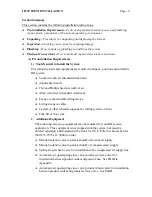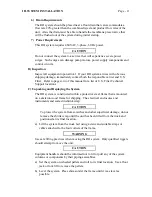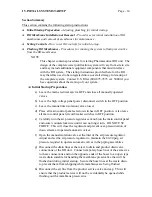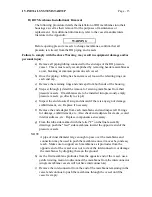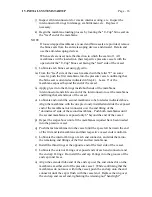
III.
SYSTEM INSTALLATION
Page - 12
c)
Remove the shrink wrap being careful not to damage protruding items such
as valves and control switches.
D)
Check Plumbing Fittings
Check all the piping on the RO system for fittings that may have been loosened
during shipment. Tighten any loose fittings or connections.
E)
Plumbing Connections
a)
Install a pipeline from the softened water supply to the inlet connection of
the RO unit. Install a manual isolation valve in this line.
b)
Install a pipeline from the product connection to the point of use. Install an
automatic air open/spring closed product service valve in this line to supply
the point of use. Connect an automatic air open/spring closed product
drain valve to this line upstream from the product service valve.
c)
Install a pipeline from the RO product drain connection to an open type
waste drain.
CAUTION
The drain must be able to accommodate a flow rate 20% greater than the
combined reject and product flow rates of the unit. Also, the drain must be
able to handle the membrane preservative that will be flushed out of the system
during initial startup.
d)
Connect an air line from SV3 (solenoid valve) on the main control panel
enclosure to the operator of the product service valve.
e)
Connect an air line from SV2 (solenoid valve) on the main control panel
enclosure to the operator of the product drain valve.
f)
Install a pipeline from the RO reject to drain connection to an open type
waste drain suitable for handling the concentrated waste water generated by
the RO unit.
g)
Install an air line from a clean compressed instrument air supply to the inlet
of the air pressure regulator on the main control panel enclosure. A spring
closed check valve should be installed in this line along with a manual
isolation valve.
CAUTION
Confirm that all upstream pretreatment equipment components and piping have
been thoroughly flushed with particle-free water before they are connected to
the RO system feed piping. Flushing removes any particles that may have
been left in the piping from cutting and assembly. If these particles are not
removed, they could cause premature fouling of the RO membranes. Refer to
Table 2 for feed water quality requirements.











